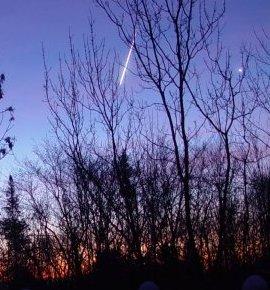 We're passing through the Leonid meteor shower, and the moon is new (meaning, there's not much of it there), so you should be able to see a lot this year.
We're passing through the Leonid meteor shower, and the moon is new (meaning, there's not much of it there), so you should be able to see a lot this year.
Some background: The Leonid meteors are debris shed into space by Comet Tempel-Tuttle, which swings through the inner solar system at intervals of 33.25 years, looping around the sun then heading back into the outskirts of the solar system. With each visit the comet leaves behind a trail of dust in its wake. Every November, the Earth, orbiting around the Sun, goes through some of those trails.
As the comet approaches the sun, it heats up, and the dust trails are quite dense. This is what happened in 1998, giving us a huge number of meteors (thousands visible per hour) in 1999, 2001, and 2002.
But Tempel-Tuttle is now receding away from the sun, so it will be a few decades before we see Leonids at that level like a decade ago. Ten meteors per hour is average. This year, however, we will be skimming the outside edge of a particular dust cloud emitted from Leonid in 1567, and (as I said), the moon won't be bright.
The comets themselves may be brighter this year, too. When the "comet bits" in the dust trail circle the sun for many hundreds of years, the tinier (dust grain) material tends to be pushed away from the sun and dispersed by the pressure of solar radiation. Conversely, because they are relatively unaffected by radiation pressure and leave the comet nucleus with less velocity than their smaller brethren do, the larger pebble-to-marble sized particles tend to linger for a much longer time. Since we're going through a centuries-old cloud, we'll see brighter comets, perhaps even a fireball or bolide (a meteor that silently explodes like a strobe along its path). About half might leave luminous trains lasting anywhere from a few seconds to a few minutes.
All in all, it means that in some parts of the world (including ours), 20-30 meteors per hour will be visible (one every 2-3 minutes).
The trick is to know when and where to look. As you might have guessed, the Leonid meteors emanate from the constellation Leo.
North Americans – especially those living near and along the Atlantic Seaboard – will be able to watch for Leonids from after 1 a.m. local time right on until the first light of dawn, which comes soon after 5 a.m. local time.
Those in the eastern U.S. and Canada are especially favored because Leo will be high in the southeast sky between 3:30 and 5:30 a.m. EST, just before Earth is expected to exit the meteor cloud. For the West Coast, this translates to 12:30 to 2:30 a.m. PST, when Leo is much lower down in the eastern sky.
That's the PEAK: 3:30 to 5:30 a.m. But obviously, you might see something prior to that, if you look in Leo.
So what should you do?
No two observers prepare for a meteor vigil the same way. It helps to have had a late afternoon nap, a shower, and to wear all fresh clothing.
Be sure to keep this in mind: at this time of year, meteor watching can be a long, cold business. Expect the ambient air temperature to be far below what your local radio or TV weathercaster predicts.
Watching a meteor shower consists of lying back, looking up at the sky . . . and waiting.
When you sit quite still, close to the rapidly cooling ground, you can become very chilled. You wait and you wait for meteors to appear. When they don't appear right away, and if you're cold and uncomfortable, you're not going to be looking for meteors for very long! Therefore, make sure you're warm and comfortable. Heavy blankets, sleeping bags, groundcloths, auto cushions, and pillows are essential equipment.
Warm cocoa or coffee can take the edge off the chill, as well as provide a slight stimulus. It's even better if you can observe with friends. That way, you can keep each other awake, as well as cover more sky.
Keep in mind that any local light pollution or obstructions like tall trees or buildings will reduce your making a meteor sighting. Give your eyes time to dark-adapt before starting. Probably the best bet is to rest on a lawn lounge, all the way back, so you can look up and see the whole sky.
 Find the constellation Leo, and locate the radiant, or originating point, of the meteor shower. The radiant rises between 1 am and 3am (EST) for the bulk of the Northern Hemisphere. The picture shows the constellation Leo to help you find it in the sky. The meteors will emanate from the "head" of the Leo.
Find the constellation Leo, and locate the radiant, or originating point, of the meteor shower. The radiant rises between 1 am and 3am (EST) for the bulk of the Northern Hemisphere. The picture shows the constellation Leo to help you find it in the sky. The meteors will emanate from the "head" of the Leo.
If you have trouble finding Leo, look for the Big Dipper. Leo is below the bottom of the dipper.

